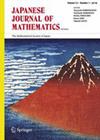Transgressions of the Euler class and Eisenstein cohomology of GL N (Z)
IF 1.5
3区 数学
Q1 MATHEMATICS
引用次数: 12
Abstract
These notes were written to be distributed to the audience of the first author’s Takagi Lectures delivered June 23, 2018. These are based on a work-in-progress that is part of a collaborative project that also involves Akshay Venkatesh.In this work-in-progress we give a new construction of some Eisenstein classes for GLN (Z) that were first considered by Nori [41] and Sczech [44]. The starting point of this construction is a theorem of Sullivan on the vanishing of the Euler class of SLN (Z) vector bundles and the explicit transgression of this Euler class by Bismut and Cheeger. Their proof indeed produces a universal form that can be thought of as a kernel for a regularized theta lift for the reductive dual pair (GLN, GL1). This suggests looking to reductive dual pairs (GLN, GLk) with k ≥ 1 for possible generalizations of the Eisenstein cocycle. This leads to fascinating lifts that relate the geometry/topology world of real arithmetic locally symmetric spaces to the arithmetic world of modular forms.In these notes we do not deal with the most general cases and put a lot of emphasis on various examples that are often classical.GL N (Z)的欧拉类越界与爱森斯坦上同
这些笔记是为了在2018年6月23日第一作者的高木讲座上分发给听众而写的。这些都是基于一项正在进行的工作,这是一个合作项目的一部分,其中也包括阿克谢·文卡特什。在这项正在进行的工作中,我们给出了一些由Nori[41]和Sczech[44]首先考虑的GLN (Z)的爱森斯坦类的新构造。该构造的出发点是Sullivan关于SLN (Z)向量束的欧拉类的消失定理以及Bismut和Cheeger对该欧拉类的显式越界。他们的证明确实产生了一种普遍形式,可以被认为是约化对偶(GLN, GL1)正则化升力的核。这建议寻找k≥1的约化对偶(GLN, GLk)来推广爱森斯坦循环。这就引出了一个有趣的提升,它将实数算术局部对称空间的几何/拓扑世界与模形式的算术世界联系起来。在这些笔记中,我们不处理最一般的情况,而是把很多重点放在各种典型的例子上。
本文章由计算机程序翻译,如有差异,请以英文原文为准。
求助全文
约1分钟内获得全文
求助全文
来源期刊
CiteScore
3.90
自引率
0.00%
发文量
2
审稿时长
>12 weeks
期刊介绍:
The official journal of the Mathematical Society of Japan, the Japanese Journal of Mathematics is devoted to authoritative research survey articles that will promote future progress in mathematics. It encourages advanced and clear expositions, giving new insights on topics of current interest from broad perspectives and/or reviewing all major developments in an important area over many years.
An eminent international mathematics journal, the Japanese Journal of Mathematics has been published since 1924. It is an ideal resource for a wide range of mathematicians extending beyond a small circle of specialists.
The official journal of the Mathematical Society of Japan.
Devoted to authoritative research survey articles that will promote future progress in mathematics.
Gives new insight on topics of current interest from broad perspectives and/or reviews all major developments in an important area over many years.

 求助内容:
求助内容: 应助结果提醒方式:
应助结果提醒方式:


